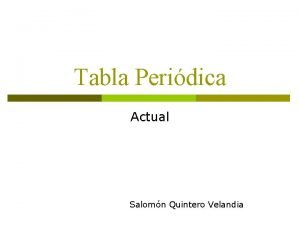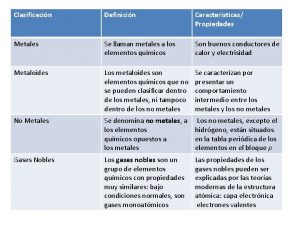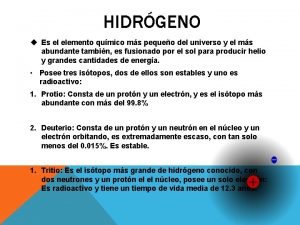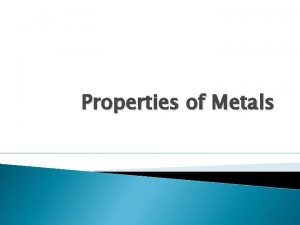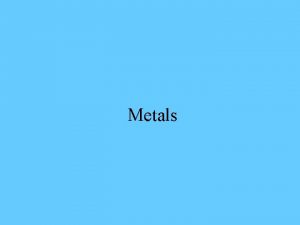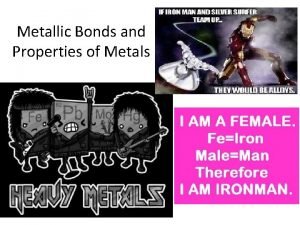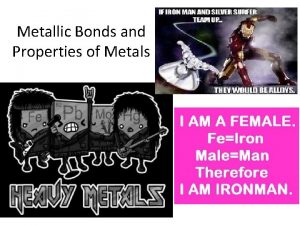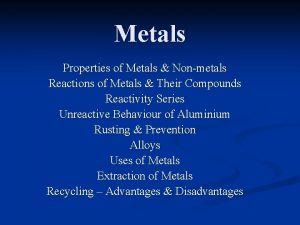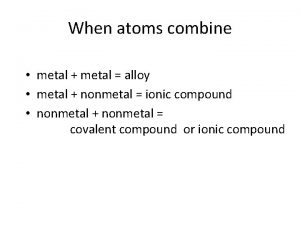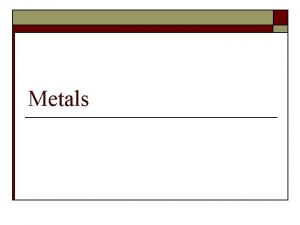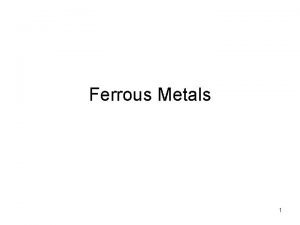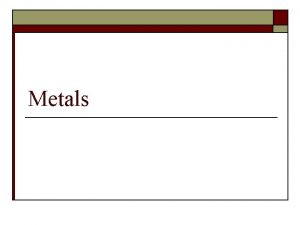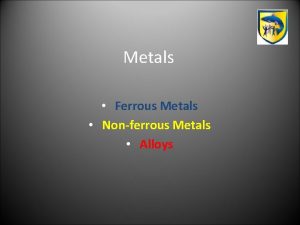METALS PROPERTIES OF METALS What is a metal














- Slides: 14

METALS

PROPERTIES OF METALS • What is a metal? • Take a moment to describe a familiar metal, such as iron, copper, gold, or silver. • What words did you use— hard, shiny, smooth? • Chemists classify an element as a metal based on its properties. • Look again at the periodic table. • All of the elements in blue-tinted squares to the left of the zigzag line are metals.

PHYSICAL PROPERTIES • The physical properties of metals include shininess, malleability, ductility, and conductivity. • A malleable (mal ee uh bul) material is one that can be hammered or rolled into flat sheets and other shapes. • A ductile material is one that can be pulled out, or drawn, into a long wire. • For example, copper can be made into thin sheets and wire because it is malleable and ductile.

• Conductivity is the ability of an object to transfer heat or electricity to another object. • Most metals are good conductors. • In addition, a few metals are magnetic. • For example, iron (Fe), cobalt (Co), and nickel (Ni) are attracted to magnets and can be made into magnets like the one in Figure 12 • Most metals are also solids at room temperature. • However, one metal—mercury (Hg)—is a liquid at room temperature.

FIGURE 12 PROPERTIES OF METALS: METALS HAVE CERTAIN PHYSICAL AND CHEMICAL PROPERTIES. CLASSIFYING CATEGORIZE EACH OF THE PROPERTIES OF METALS THAT ARE SHOWN AS EITHER PHYSICAL OR CHEMICAL.

CHEMICAL PROPERTIES • The ease and speed with which an element combines, or reacts, with other elements and compounds is called its reactivity. • Metals usually react by losing electrons to other atoms. • Some metals are very reactive. • For example, you read that sodium (Na) reacts strongly when exposed to air or water. • To prevent a reaction, sodium and metals like it must be stored under oil in sealed containers. • By comparison, gold (Au) and platinum (Pt) are valued for their lack of reactivity and because they are rare.

• The reactivities of other metals fall somewhere between those of sodium and gold. • Iron, for example, reacts slowly with oxygen in the air, forming iron oxide, or rust. • If iron is not protected by paint or plated with another metal, it will slowly turn to reddish-brown rust. • The destruction of a metal through this process is called corrosion.

METALS IN THE PERIODIC TABLE • The metals in a group, or family, have similar properties, and these family properties change gradually as you move across the table. • The reactivity of metals tends to decrease as you move from left to right across the periodic table

ALKALI METALS • The metals in Group 1, from lithium to francium, are called the alkali metals. • Alkali metals react with other elements by losing one electron. • These metals are so reactive that they are never found as uncombined elements in nature. • Instead, they are found only in compounds. In the laboratory, scientists have been able to isolate alkali metals from their compounds. • As pure, uncombined elements, some of the alkali metals are shiny and so soft that you can cut them with a plastic knife.

• The two most important alkali metals are sodium and potassium. • Examples of potassium are shown in Figure 13. • Sodium compounds are found in large amounts in seawater and salt beds. • Your diet includes foods that contain compounds of sodium and potassium, elements important for life. • Another alkali metal, lithium, is used in batteries and some medicines.

FIGURE 13 ALKA LI METALS POTASSIUM IS AN ALKALI METAL. MAKING GENERALIZATI ONS WHAT CHARACTERIST ICS DO OTHER GROUP 1 ELEMENTS SHARE WITH POTASSIUM?

ALKALINE EARTH METALS • Group 2 of the periodic table contains the alkaline earth metals. • Each is fairly hard, gray-white, and a good conductor of electricity. • Alkaline earth metals react by losing two electrons. • These elements are not as reactive as the metals in Group 1, but they are more reactive than most other metals. • Like the Group 1 metals, the Group 2 metals are never found uncombined in nature.

• The two most common alkaline earth metals are magnesium and calcium. • Mixing magnesium and a small amount of aluminum makes a strong but lightweight material used in ladders, airplane parts, automobile wheels, and other products. • Calcium compounds are an essential part of teeth and bones. • Calcium also helps muscles work properly. • You get calcium compounds from milk and other dairy products, as well as from green, leafy vegetables.

FIGURE 14 ALKALINE EARTH METALS CALCIUM IS ONE OF THE GROUP 2 ELEMENTS.
 Processed materials grade 5
Processed materials grade 5 Non metals in the periodic table
Non metals in the periodic table Grade 7 natural science term 2
Grade 7 natural science term 2 Ferrous metals
Ferrous metals Reactivity periodic trend
Reactivity periodic trend Metal vs nonmetal
Metal vs nonmetal Grupo b tabla periódica
Grupo b tabla periódica Venn diagram of 3 states of matter
Venn diagram of 3 states of matter Non metals and uses
Non metals and uses Propiedades de los materiales metalicos
Propiedades de los materiales metalicos Dr terry blanch
Dr terry blanch Difference between metal oxides and non metal oxides
Difference between metal oxides and non metal oxides Periodic table pure substances
Periodic table pure substances Hidrgeno
Hidrgeno Non metals melting and boiling points
Non metals melting and boiling points






